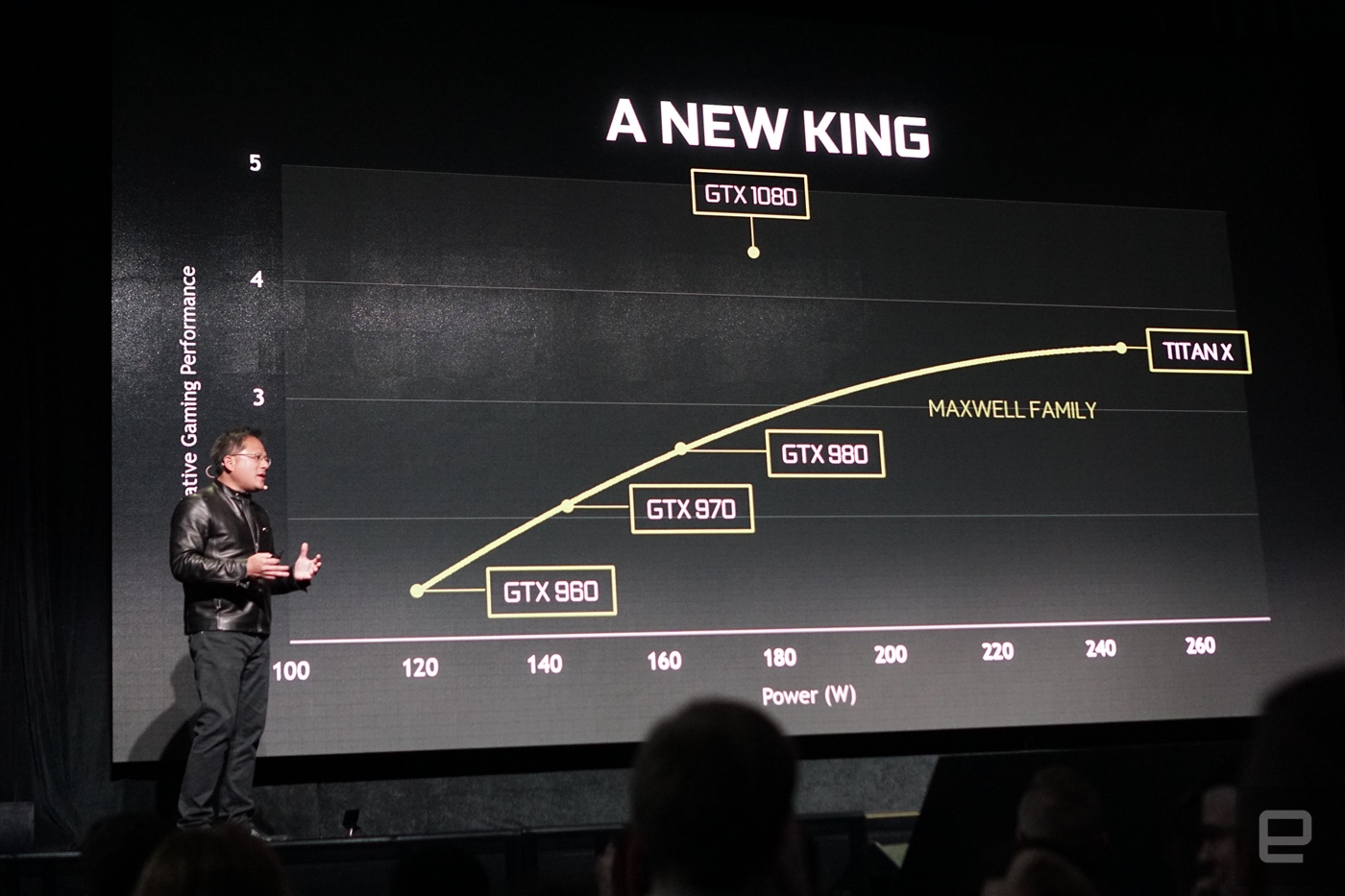NVIDIA gave us a taste of its new Pascal architecture with the*P100 graphics card*last month, which is aimed at servers for heavy duty computing. Now, it's ready to show off how that technology will be adapted for consumers with its new GeForce GTX 1080 GPU. As you'd expect, it's fast: NVIDIA CEO Jen-Hsun Huang revealed that it's twice as fast as its current performance king, the Titan X, as well as three times as power efficient. The 1080 also faster than two GTX 980 cards running together using SLI technology. Like the P100, the 1080 is built with a new 16nm FinFET (a type of 3D transistor) manufacturing process, which makes it more power efficient, on top of just being faster.
The GTX 1080 is the "largest GPU endeavor, largest chip endeavor, largest processor endeavor, in the history of humanity," said NVIDIA CEO Jen-Hsun Huang. He added that the R&D budget for the new card was "several billion dollars" over the span of more than two years. "I'm pretty sure you can go to Mars [for that]," he said.
NVIDIA is basically positioning the GTX 1080 as the gamer's dream card. Prior to its unveiling, Huang showed off several new titles like The Division and Rise of the Tomb Raider running at max settings in a high resolution over 60 frames per second. He later revealed that all of the games were running on the new card, to the delight of the entire crowd.
The GTX 1080 will be available for $599 on May 27, and you can also snag a special NVIDIA-designed "founders edition" for $699 (which looks like it includes a stylish new cooler). Almost as an afterthought, NVIDIA also revealed that the GTX 1070 is coming on June 10 for $379 (the founders edition will run you $449).
NVIDIA didn't have too many technical details to share about either card, but it loud out a few stats: The 1080 pumps out 9 teraflops and packs in 8GB of RAM. The 1070, which is*also*faster than the Titan X, spits out 6.5 teraflops and also has 8GB of RAM. For the smart gamer, it sounds like the GTX 1080 will be a pretty good deal (just like the 970 was).
But of course, NVIDIA won't be alone with new hardware this year. AMD is expected to debut new cards with its Polaris technology this summer, which will focus on power efficiency as well. It sounds like Polaris is better suited for gaming laptops at the moment, but it could also be a way for AMD to deliver some powerful cards that you can actually afford (think under $300).
NVIDIA's GTX 1080 GPU is twice as fast as Titan X
Results 1 to 10 of 68
Thread: Nvidia Announces GTX 1080 & 1070
-
05-07-2016, 10:38 AM #1
 Nvidia Announces GTX 1080 & 1070
Nvidia Announces GTX 1080 & 1070
Last edited by kenniku_you; 05-07-2016 at 10:52 AM.
-
05-07-2016, 11:19 AM #2
Last edited by backstabbd88; 05-08-2016 at 10:25 AM.
-
05-07-2016, 08:18 PM #3
omg omg omg. dmd oi!!!! The 1070, which is*also*faster than the Titan X ,,, kusuga naman ni
-
05-07-2016, 10:31 PM #4Newbie

- Join Date
- Sep 2015
- Gender

- Posts
- 88
http://www.yugatech.com/personal-com...raphics-cards/
Ganahan kos 1070... mga 18k ra daw.. insakto kaayo August pa uli ako friend gikan gawas, imbis gtx 970 ako ipapalit... 1070 nalang
-
05-08-2016, 02:19 PM #5
Gisubay2yan gyud ko ni OrderOf10
Murag time for an upgrade nah gyud.
Akong GTX 970 SLI, ibaligya nsad ni nako haha
-
05-08-2016, 03:47 PM #6
-
05-08-2016, 04:18 PM #7
layu kaayug diperensya sa performance gud bro hahaha
Power efficiency sad samut!
Ang temps, sus!
Dayun new hybrid SLI pah gyud.
Daghan kayg symptoms bro, di mapugngan. hahah
1070 rah nuon gihapon akong plano SLI. haha
Akong platform tawn Z77 gihapon haha
Inig 7th gen nah guro ko upgrade haha
Grabeha aning sakita oe haha
-
05-08-2016, 05:05 PM #8
^ hahahaha. Wala gyu'y antidote ni na sakit bro... "Nganong ni enter"... Hahahaha
-
05-08-2016, 07:16 PM #9
<a href="https://www.youtube.com/watch?v=yRxoWkSDhVc" target="_blank" rel="nofollow"> https://www.youtube.com/watch?v=yRxoWkSDhVc
sakita siguro sa dughan sa mga bago ra nakapalit og 970/980/980ti& titan x.
-
05-08-2016, 07:30 PM #10
 Game : Doom (2016)
Game : Doom (2016)
Last edited by Burn Out; 05-08-2016 at 07:43 PM.
Advertisement
Similar Threads |
|







 Reply With Quote
Reply With Quote

